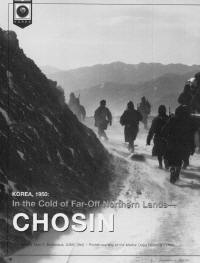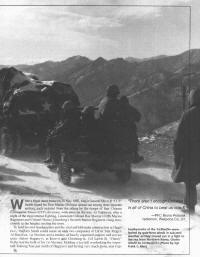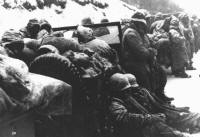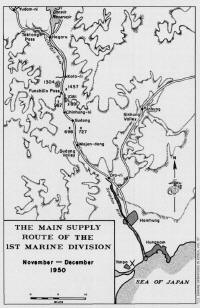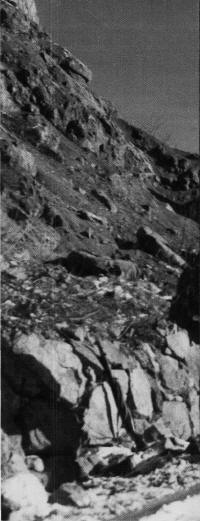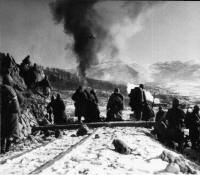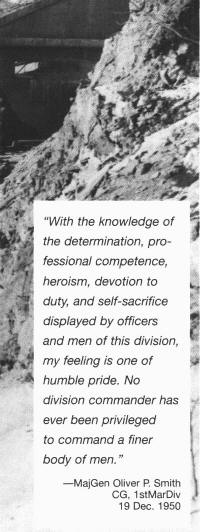 |
||||
 |
||||
Gene Dixon Memoir |
||||
|
||||
Korea, 1950: In the cold of far-off northern lands--Chosin |
||||
PART 2 |
||||
| Allan C Bevilacqua. Leatherneck. Quantico: Quantico: Dec 2000.Vol. 83, Iss. 12; pg. 18, 8 pgs Copyright Marine Corps Association Dec 2000 |
||||
|
When a frigid dawn broke on 28 Nov. 1950, Major General Oliver P "O. P." Smith found his First Marine Division spread out among three separate sectors, each isolated from the others by the troops of four Chinese Communist Forces (CCF) divisions, with more on the way. At Yudam-ni, after a night of the most intense fighting, Lieutenant Colonel Ray Murray's Fifth Marine Regiment and Colonel Homer Litzenberg's Seventh Marine Regiment clung tenaciously to the heights circling the town. To hold his own headquarters and the vital airfield under construction at Hagaru-ri, MajGen Smith could count on only two companies of LtCol Tom Ridge's 3d Battalion, I st Marines and a medley of hastily organized support and service units. Below Hagaru-ri, at Koto-ri and Chinhung-ni, Col Lewis B. "Chesty" Puller had the bulk of his 1st Marines. Holding a key hill overlooking the important Toktong Pass just north of Hagaru-ri and feeling very much alone, was Captain Bill Barber's "Fox" Co, 2/7. It is doubtful that a Marine division confronted by an enemy determined to destroy it has ever been strung out in such a fashion. The arrival of daylight did not bring an end to the fighting. Reinforcements from 1/5 and 3/5, sent into the hills to relieve units battered during the night and restore positions, clashed bitterly with Chinese attackers. On its lonely hill between Yudam-ni and Hagaru-ri-a hill soon to be known as Fox Hill-Capt Barber's Fox Co, 2/7 clung to its critical position after a nightlong firefight that left 20 of its members dead and 45 wounded. Sprawled in death before Fox Co's positions were some 300 Chinese. Many of them were killed by Private Hector Cafferata, blazing away with an M1 rifle, catching live grenades and throwing them back, and using the butt of his rifle as a baseball bat to return other grenades to their senders. Cafferata's actions would in time bring him the nation's highest award for valor, the Medal of Honor. About noon on the 28th the clouds parted, and an uninterrupted stream of Marine Corsairs and Navy Skyraiders arrived over Yudam-ni and Fox Hill, sending the Chinese to ground. It was a pattern that would be repeated through the days to come. The nights would blaze and crackle with the sounds of combat as the Chinese attackers sought to overwhelm the defenders of Yudam-ni and obliterate Fox Co to complete the encirclement of the 5th and 7th Marines. By day Marine artillery and air would make it perilous for any Chinese soldier to show his head. By night and by day the Chinese paid a fearful price for their efforts. On the night of 28-29 Nov., these efforts, in addition to being renewed against the defenses of Yudam-ni and Fox Hill, were directed at Hagaru-ri. With its four-milelong perimeter manned by the two rifle companies of 3/1 and makeshift units of mechanics, clerks, cooks, air controllers and engineers, Hagaru-ri was vulnerable to say the least, the defense spread dangerously thin and with no depth. There was too much ground to defend and nothing approaching the manpower necessary to defend it. The fight at Hagaru-ri would have to depend on something more than numbers. It would need raw courage, iron determination and esprit de corps in large measure. It would need fighters. Following almost exactly the script determined by Second Lieutenant Richard E. Carey, 3/1's intelligence officer, the Chinese launched human-wave attacks from the southwest at 2130. Waiting for them, armed with Carey's intelligence, were Capt Clarence Corley's How Co and First Lieutenant Joseph "Bull" Fisher's Item Co. Both companies were on full alert and well dug in, thanks to foxholes blasted out of the rock-hard soil by homemade shaped-- charges fashioned from C-3 plastic explosives packed into C-ration cans. The attacks began without any preliminaries, accompanied by the same din and cacophony that had become standard background music for Chinese onslaughts. The Chinese were staggered by the combined firepower of Corley's and Fisher's companies, reinforced by attachments from Weapons Co and the 90 mm fires of a pair of M26 tanks. Attacking Chinese fell in windrows. As at Yudam-ni, more filled their places, breaching the junction of How and Item companies by sheer masses and threatening the vital airfield where engineers worked by floodlights even in the midst of the fighting. In a furious fight that seesawed back and forth for several hours, Corley's Marines, aided by hastily organized engineer heavy equipment operators and personnel from 3/1's headquarters, finally threw the attackers out. While the attacks against Hagaru-ri's southwest perimeter were underway, another massive Chinese assault was thrown at Hagaru-ri's dominant terrain feature, a bulky hill mass to the east known logically enough as East Hill. There, too, masses of Chinese attackers breached the defenders' lines simply by inundating them beneath a sea of bodies. A complete breakthrough was averted only when the cannoneers of Capt Ben Reads How Co, 3/11 trained their tubes point-blank at the charging Chinese and shredded them with a hail of 105 mm shells. The command of "Fire at will," rarely heard on the gunline, was answered by loaders feeding a stream of projectiles into the breeches of the belching howitzers. When it was all over, Sergeant Vince Mosco counted more than 100 empty shell canisters around his gun. It may not have been the first time an artillery battery held a sector of a defensive line, but it saved Hagaru-ri. An entire CCF division, the 58th, attacked Hagaru-ri that night. In desperate fighting, one of its three regiments was shot to tatters and a second badly mauled. While fighting was raging about Yudam-ni, Hagaru-ri and Fox Hill, fresh Chinese units were preparing for attacks against Koto-ri and Chinhung-ni. Yet another CCF division, the 60th, had entered the fray. By day they laid low in the houses of Korean civilians scattered throughout the area. By night they conducted probing attacks to determine the strength and nature of the Marine defenses. And they demonstrated their intent to shut down the vital main supply route (MSR) linking the Marine enclaves along it. With the arrival of yet another frigid day on 29 Nov., aerial reconnaissance revealed that the Chinese had destroyed two bridges and set up eight roadblocks in the 11 miles that separated Hagaru-ri and Koto-ri. At his headquarters at Koto-ri, Chesty Puller, the 1 st Marines combative commander always eager for a fight, saw this as an opportunity. "We've been looking for the enemy for several weeks now," Puller told a group of newsmen. "We've finally found them. We're surrounded. That simplifies our problem of finding these people and killing them." Puller's views of the circumstances may have been lost on Private First Class Bruno Podolak, a radioman in Major Ed Simmons' Weapons Co, 3/1. Podolak was up to his belt buckle in Chinese, hiding out on East Hill and maintaining surreptitious radio contact with Simmons, sending continuous situation reports as Marine counterattacks and Chinese parries surged back and forth across the vital hill. Podolak maintained his lonely vigil until he was reached by friendly troops, then continued on with them as Simmons' radioman. A short while later he was shot in the back by a round that first went through his radio. Podolak remained in action, one of many wounded Marines who kept on fighting. The struggle ended in a virtual deadlock, with each side holding portions of the hill. It was fast becoming obvious that the Chinese wanted Hagaru-ri and its airfield and wanted it badly. With the airfield in Chinese hands there would be no hope of bringing in much needed supplies and reinforcements. Despite the risks involved, Hagaru-ri had to be reinforced, and early on 30 Nov. MajGen Smith directed Puller at Koto-ri to push a force through to Hagaru-ri. In short order a column consisting of Capt Carl Sitter's George Co, 3/1, a platoon each from Baker and Dog companies, 1 st Tank Bn, an attached Army company, headquarters and service personnel, and the 235 members of 41 Independent Commando, Royal Marines was assembled. In overall command of the column was LtCol Douglas Drysdale, Royal Marines.
It was a desperate throw of the dice, and it succeeded only in part. Attacked from both sides by overwhelming numbers of Chinese, only the lead elements of the column-the tanks, Sitter's George Co, 3/1 and the Commandos-were able to break through to Hagaru-ri as darkness descended. As night settled on the area, the members of the relief force were dumbfounded to see engineers still working under floodlights and ignoring incoming fire to put the final touches on the airfield. Even as the fighting flared and crackled about Hagaru-ri, the distant rumbling from the north told them that Fox Hill and Yudam-ni were getting their own share of attention, while the thermometer continued to skid and snow fell. The Chinese weren't finished. Just before midnight on 30 Nov., as they had two nights earlier, the Chinese inexplicably sent waves of attackers against the strongest sector of Hagaru-ri's defenses, "Bull" Fisher's Item Co, 3/1. At a cost of two Marines killed and 10 wounded, Item Co stacked up between 500 and 700 Chinese corpses. Another Chinese attack at East Hill resulted in a costly stalemate. In midafternoon of 1 Dec., the first twin-engine C-47 landed at the Hagaru-ri airstrip, the inaugural flight of what would become around-the-clock sorties to bring in supplies and reinforcements and to evacuate wounded. The stage was now set for the 1stMarDiv to turn on its tormentors and wrest the initiative from them. While Marines at Hagaru-ri were cheering the arrival of the first transport plane, LtCol Bob Taplett's 3/5 was leading the breakout from Yudam-ni. Behind Capt Hal Williamson's How Co, 3/5 was the entire strength of the 5th and 7th Marines, men, vehicles and equipment, headed for Hagaru-ri. Except for their drivers the only occupants of the vehicles in the column were the dead and those too seriously wounded to walk. Swinging off to the east, trekking overland to attack the besiegers of Fox Hill from behind, was LtCol Ray Davis' 1/7. It was not going to be a brisk winter hike. The Chinese could be expected to resist strenuously every step of the way. The companies were smaller than they had been only short days before. The Marines in the thinned ranks were haggard and hollow-eyed from lack of sleep. They were bearded, scroungy and dirty beyond belief, their clothing torn, bloodstained and blackened by powder burns. They were malnourished and suffering the ravages of raging diarrhea and enteritis from skimpy meals of frozen rations. They were vermin-ridden. They stank. And they were in a vile humor, possessed of a cold, purposeful rage that boded ill for any Chinese who crossed their path. Their orders were simple: "The attack will start at 0800 on 1 Dec. Objective: Hagaru." During the next three days-it took that long to traverse the 14 miles separating Yudam-ni from Hagaru-ri-Litzenberg's and Murray's bone-weary Marines slugged it out with Chinese desperate to prevent them from reaching their objective. The attack was punctuated by a never-ending succession of roadblocks and attempted ambushes, each of them overcome in turn. In the skies overhead Marine and Navy aviators flayed the Chinese with bombs, rockets, gunfire and napalm. In the hours of darkness night-- prowling Grumman F7F Tigercats of LtCol David Wolfe's Marine Night Fighter Squadron 513 continued to seek out targets. As the column battled its way southward, the temperature descended to unimagined depths, 35 degrees below zero. During the night of 2-3 Dec., six inches of snow fell, reducing visibility to yards. While the bulk of the Yudam-ni garrison was smashing its way through all-or-nothing Chinese resistance, Ray Davis' 1/7 was engaging in an epic of human endurance in its overland trek to relieve the defenders of Fox Hill. Slipping and stumbling up icy hillsides, floundering through snow that was sometimes knee-deep, Marines nearing the point of complete exhaustion somehow found it in themselves to take one more step and then one more and yet one more. In the bleak, frozen landscape, men to whom the phrase "mindnumbing cold" had once been words read in a book found themselves calling upon their last reserves of concentration to accomplish the simplest of tasks. Still they went on. Shortly before 1130 on 2 Dec., the lead elements of 1/7 linked up with the defenders of Fox Hill. They found a landscape littered with the corpses of fallen Chinese and a Fox Co that had been reduced by 118 casualties, but which still clung tenaciously to its vital hillside. Among the Fox Co wounded was Bill Barber, wounded in the hip and unable to walk unaided, but still in command. Barber would join Hector Cafferata, the "one-man war," as a winner of the Medal of Honor. So would Ray Davis. With the linkup of Davis' force and the road column the next day, the Chinese couldn't prevent anyone from reaching Hagaru-ri. Now their attempts to stem the flow were lacking the savagery that had characterized their earlier efforts. The long line wound its way wearily toward Hagaru-ri, the men in it stumbling from fatigue, some of them asleep on their feet. Firefights continued to pop and sputter about them. Then, as the lead approached the Hagaru-ri perimeter at 1900 on 3 Dec., something happened that those who were there still speak of today. Backs were straightened, shoulders were thrown back, weapons were shifted to the position of sling arms. Imperceptibly, tired, slogging legs picked up the cadence until hundreds of feet were pounding the rock hard roadway in perfect unison. Heads up and moving in impeccable cadence the Yudam-ni Marines marched into Hagaru-ri. In the ranks of onlookers, Navy Lieutenant Junior Grade Robert Harvey, who had served as battalion surgeon with 3/5 during the summer, watched his old outfit come marching in, murmuring over and over, "Look at those bastards, those magnificent bastards." Still on duty despite his wounds, radioman Bruno Podolak saw something different in the long ranks. "There aren't enough Chinese in all of China to beat us now," he said to himself. Podolak's upbeat mood may have been dampened somewhat had he known how many of the Yudam-ni garrison were far from ready for a fight. Included in the column were hundreds of wounded and hundreds more suffering the ravages of the unrelenting cold. During the next three days, while the division regrouped at Hagaru-ri and replacements and supplies were flown in, more than 4,000 casualties were evacuated. While this effort was going on around the clock, the bulk of the division began preparing for the next stage of the attack to the south, the linkup with Puller's force at Koto-ri. Before that attack could begin, there was the vexing matter of East Hill to be attended to. With its crest still held in strength by the Chinese, East Hill dominated the line of march. Until they were eliminated, no one was going anywhere. The task fell to LtCol Hal Roise's 2/5 that had been so hard-pressed at Yudamni. After a bitter daylong battle, supported by the 5th Marines' 4.2-inch mortars and the constantly swarming Corsairs, the hill was taken once and for all late in the day on 6 Dec. That night the Chinese launched a massive attack at the hill. Roise's lines lit up like sheet lightning in a constant crash of gunfire as serried ranks of Chinese threw themselves at the defenders. It was a slaughter. Daylight revealed the slopes of East Hill carpeted with the frozen bodies of almost 1,000 of the attackers. The advance to Koto-ri began shortly later. The Chinese tried to stop it. They couldn't. Even while the fighting raged on East Hill, Col Homer Litzenberg's 7th Marines began the drive to Koto-ri. There was resistance every step of the way. In a continual running gun battle, position after position was swept aside and ground under. It was accomplished mostly through sheer determination by Marines who were staggering with fatigue, malnourished and suffering the brutal effects of the cold and wind. Nothing stopped the Marines. Engineers spanned a communist-blown gap in the narrow roadway with an air-dropped Treadway bridge. The leathernecks brought out their dead, wounded and equipment. In the midst of it all, there was a strange reunion, one of those little things that pop up here and there in war. Trudging along in the ranks of LtCol Bill Harris' 3/7, rifleman John Young, a Tidewater Virginian from Norfolk, glanced casually at a tanker lounging beside the turret of his tank. The tanker was munching a large candy bar. As Young drew closer, the tanker's face became more distinct. It was his high school and boot camp buddy, Bruno Anderson, whom Young hadn't seen since Parris Island more than a year before. Young's greeting was brief and to the point. "Bruno, give me some of that damn candy bar." (Both Young and Anderson completed their front-line tours in Korea without a scratch. Retired Maj John Young and retired SgtMaj Bruno Anderson live in Tidewater, Va., today.) The advance went on. The Chinese inflicted casualties, but they themselves died almost to the man. More and more Chinese were found dead of disease and starvation. The bodies of entire platoons were found frozen to death. Napalm from the ever-present Corsairs and Skyraiders turned companies and battalions into smoldering funeral pyres. With rifles, BARs and machine guns, the rifle companies stacked the bodies of Chinese like firewood. As dusk draped itself on the hills overlooking Koto-ri on 7 Dec., the 7th Marines filed slowly into the perimeter. They were out on their feet, but they brought their wounded and their dead with them. Close behind came the 5th Marines and Tom Ridge's 3/1. What they left behind at Hagaru-ri was a smoldering ruin. Nothing of value, not even shelter, was abandoned to the Chinese. What could not be carried with the column was burned, blown up or ground under the tracks of bulldozers. Explosions shook the ground and billowing clouds of thick, black smoke lit by lurid red flames turned Hagaru-ri into something of a cross between a volcano and an inferno. To the accompaniment of erupting stocks of ammunition and fuel, the Marines of Capt Bill Gould's Able Co, 1 st Engineer Bn, the last Marines to depart Hagaru-ri, turned and started south to Koto-ri. There were smiles among them. To combat engineers, few things are so satisfying as the opportunity to blow something up. Just before midnight, as 7 Dec. was about to tick off the clock, they entered the perimeter. The move from Hagaru-ri to Koto-ri was completed. Still the Chinese had one more card to play. Below Koto-ri, where the pathway to the sea passed close beside the Changjin Power Plant, the road crossed a bridge over a deep gorge. The Chinese blew the bridge. There was no bypass, only a precipitous drop on one hand and a sheer rock face on the other. Even this had been anticipated. Using sections of a Treadway bridge that had been air-dropped into Koto-ri, the gap was spanned, and the march resumed. Nothing stopped the Marines. Engineers spanned a communist-blown gap in the narrow roadway with an air-dropped Treadway bridge. The leathernecks brought out their dead, wounded and equipment. Now only the Chinese defenders atop a hill numbered 1081, less than five miles below the bridge, remained to deny the 1stMarDiv its return to the sea. Driving north from Chinhung-ni, LtCol Don Schmuck's 1/1 battled through a blinding snowstorm to assault the hill on 8 Dec. The Chinese resisted desperately. In two days of furious fighting, before Capt Bob Barrow's Able Co, 1/1 secured the crest, an entire Chinese battalion, more than 530 men, was annihilated. The last Chinese throw of the dice had come up snake eyes. Shortly after midnight, as the new day of 12 Dec. was beginning, the first serials of the 1stMarDiv entered the LST staging area at the port of Hungnam to begin backloading. Looking back at it, the Chosin Reservoir Campaign may be seen as having been conducted in three phases. Initially, there was the advance to the reservoir itself during the middle and last weeks of November. This was followed by the defensive phase, as the separate Marine garrisons stood fast in the face of massive CCF attacks. Lastly, there was the attack to the south as Marines fought their way successively from Yudam-ni to Hagaru-ri to Koto-ri to Chinhung-ni and eventually to the sea. During the course of this epic battle the 1stMarDiv engaged and decisively defeated seven CCF divisions along with elements of three others. Five of these divisions were completely destroyed; they never again appeared in the Korean War. The mission of Gen Sung Shihlun's 9th Army Group-to annihilate the 1stMarDiv-had been a disastrous failure, costing the lives of more than 25,000 of its soldiers. The 10 Medals of Honor and 70 Navy Crosses awarded to members of the 1 stMarDiv stand as testimony to the courage and fortitude of every Marine who took part in one of the finest moments in Marine Corps history. |
||||
|
||||
 |
